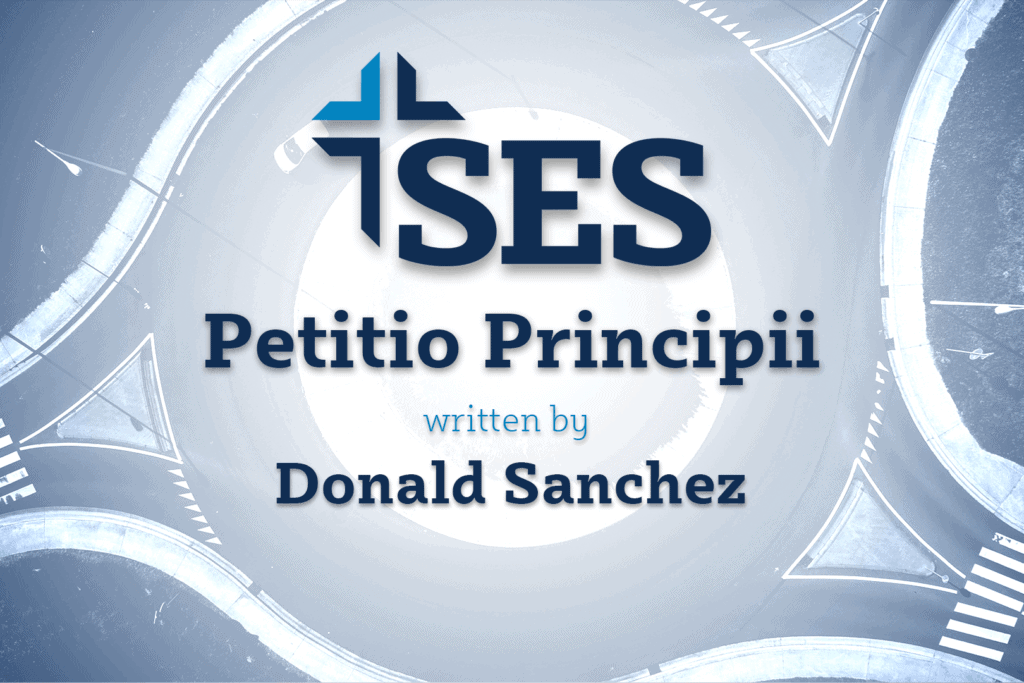[et_pb_section bb_built=”1″ admin_label=”section”][et_pb_row admin_label=”row” background_position=”top_left” background_repeat=”repeat” background_size=”initial”][et_pb_column type=”4_4″][et_pb_text background_layout=”light” text_orientation=”left” use_border_color=”off” border_color=”#ffffff” border_style=”solid” background_position=”top_left” background_repeat=”repeat” background_size=”initial”]
Introduction
Imagine three cowboys riding up to a saloon on their trusty horses. The first cowboy, rather than tying the reins of his horse to a grounded post, ties it instead to the horse of the second cowboy, who in turn ties his horse to the horse of the third. The three cowboys enter the saloon confident that their horses are secured only to find all three have run away—together! Like the three horses in the petitio principii fallacy, the premises of the argument are tied to one another rather than being grounded in something independent. (See A. J. Hoover, Don’t You Believe It! Poking Holes in Faulty Logic, 41.)
Petitio Principii (lit. “laying claim to a principle”) is what philosopher Peter Kreeft identifies as a “fallacy of argumentation” (Peter Kreeft, Socratic Logic, 92). Kreeft compares it to a bad military strategy because the form of the argument just doesn’t work. Petitio principii is also popularly known as “begging the question,” or simply as arguing in a circle (i.e., X is true because of Y and Y is true because of X).
Petitio Principii Definition
Begging the question occurs when someone assumes in the premises the conclusion of the argument. Recall that the premise of an argument is a declarative sentence that either affirms or denies a truth claim. So, what someone presupposes to be the case in his reasoning is exactly what it is they are trying to prove in the conclusion. This fallacy is a very common one, but it is very often difficult to recognize because the “wording often obscures the fact that buried within one of the premises assumed lies the conclusion itself” (Irving M. Copi and Carl Cohen, Introduction to Logic 11th ed.). In this series, we have dealt with fallacies of relevance and fallacies of weak induction. The petitio principii fallacy is neither, as it does “prove” the conclusion, but it does so trivially. That is to say, it does so superficially or without force.
For example, suppose one night you order a large pizza, which was delivered and cut into eight slices. You and your three friends are very hungry, and you all salivate, looking at the melted cheese and crunchy crust. You give your three friends one slice each and keep four for yourself. “Hey, what’s up with that?” they protest. “Why do we get only one slice and you get four?” “The reason I get four slices is because I’m the smartest one at the table, and everyone knows that the smartest one at the table gets the most slices of pizza.”
What just happened? You smuggled into your reasoning (“I get four slices because I’m the smartest”) the conclusion of your argument (“the smartest one at the table gets the most slices”).You can see why this is known as “arguing in a circle.” Your friends protest further saying, “Who says you’re the smartest one at the table?” Your answer is simple, “The fact that I have the most slices of pizza proves that I’m the smartest one at the table!” And on and on the argument goes. The figure below illustrates the argument.
Examples of Committing the Fallacy
The above example may be a silly one, but it does illustrate the point. What are some other examples of begging the question?
- Christians believe the Bible is the Word of God. What if someone asks you, “Why do you believe this?” What would your answer be? If you say, “Because the Bible says it is the Word of God, therefore that proves it is the Word of God,” you are begging the question.
- Fred says that he believes UFOs are real because he has seen what can only be described as UFOs.
- Kathy tells you she is the most honest person at work; therefore, whatever she says must be true.
- A skeptic doesn’t believe in miracles, so any so-called “miracle,” he will argue, must have a natural explanation.
- Robert is camping with John and says, “These two mushrooms look alike, but I know one of them is poisonous. How can I tell which is which?” “The best way to answer that question,” replies John, “is to eat one, and if it’s poisonous, you’ll know which of the two mushrooms not to eat.”
- A sign at the doctor’s office warns that smoking cigarettes can kill you because cigarettes are deadly.
- The Bible cannot be true because it contains miracles, and everyone knows miracles would violate the laws of nature.
- The Pope is infallible because whatever the Pope says is true.
How to Avoid Committing the Fallacy
Avoiding the petitio principii fallacy will require careful attention on your part. Logician Irving Copi writes, “Sometimes we fall into this mistake when, in an effort to establish our conclusion, we cast about in search of premises that will do the trick” (Copi, 159). First and foremost, to avoid committing the fallacy you must insure that what you are trying to prove is not already stated in the conclusion of your argument. In other words, your argument should not be a slightly altered form of your conclusion. Taking one of the examples above, if someone were to ask you why you believed the Bible is the Word of God (as already noted), it is not enough to simply answer, “Because the Bible is an infallible book and claims God is its author; therefore that proves that the Bible is the Word of God.” This is a case of the horses tied to one another while galloping away together.
In contrast, you may, for example, appeal to the prophetic nature of the book as an independent anchor. The ability to accurately predict future events is not something that someone can either do or explain through natural causes. People simply do not have the ability to “see” in the future. However, there are hundreds of very specific, detailed prophecies that were recorded in the Bible centuries prior to their fulfillment. The ability to accurately predict the future is a hallmark of a supernatural cause and is therefore evidence of a divine “fingerprint.”
For instance, the Old Testament prophet Jeremiah predicted Babylonian King Nebuchadnezzar would take Judah into captivity for a period of 70 years (Jer. 25:11) long before that historical event occurred. Daniel accurately foretold that the Babylonians would be conquered by the Medo-Persians, who would in turn be conquered by the Greeks (Dan. 8:20ff) while Babylon was still a world power. Jesus warned the disciples of the destruction of the Second Temple well before Rome leveled the city in AD 70 (Matthew 24). The fulfillment of these historical events were so accurate and remarkable that critics of the Bible insist the books of Jeremiah and Daniel were written after the fact because there is simply no natural explanation as to how both Jeremiah and Daniel could have known what would take place.
So, in answering the question how do you know the Bible is God’s written Word, you could begin to argue the case by stating it this way:
- Accurately predicting future events is evidence of a supernatural cause.
- The Bible records accurately fulfilled predictions of future events.
- Therefore, the Bible is evidence of a supernatural cause.
While you may need to offer further evidence to show that God is the author of the 66 books of the Bible, in this instance, you are not simply arguing in a circle. Do you see the difference? The first argument assumes the conclusion it is trying to prove. However, in the second argument, if the first two premises are true and the form of the argument is valid, then the conclusion must follow necessarily.
It is vitally important that we not only have the ability to recognize logical fallacies, but that we also avoid committing them ourselves. Southern Evangelical Seminary offers classes in logic and critical thinking. If this series, Logical Fallacies 101, is encouraging you to learn more about the topic, please consider enrolling at the school to take these classes and further your education and ministry.
[/et_pb_text][et_pb_divider show_divider=”off” color=”#ffffff” divider_style=”solid” divider_position=”top” hide_on_mobile=”on” /][et_pb_text background_layout=”light” text_orientation=”left” use_border_color=”off” border_color=”#ffffff” border_style=”solid” background_position=”top_left” background_repeat=”repeat” background_size=”initial”]
References
Copi, Irving M. and Carl Cohen. Introduction to Logic 11th ed. Upper Saddle River, NJ: Prentice Hall, 2002.
Damer, T. Edward. Attacking Faulty Reasoning: A Practical Guide to Fallacy-Free Arguments 3rd ed. Belmont, CA: Wadsworth Publishing Company, 1995.
Hoover, A. J. Don’t You Believe It: Poking Holes in Faulty Logic. Chicago: Moody Press, 1982.
Kreeft, Peter. Socratic Logic: A Logic Text Using Socratic Method, Platonic Questions, and Aristotelian Principles. Edited by Trent Dougherty. 3.1 ed. South Bend, IN: St Augustine’s Press, 2014.
[/et_pb_text][et_pb_divider show_divider=”off” color=”#ffffff” divider_style=”solid” divider_position=”top” hide_on_mobile=”on” /][/et_pb_column][/et_pb_row][/et_pb_section]






